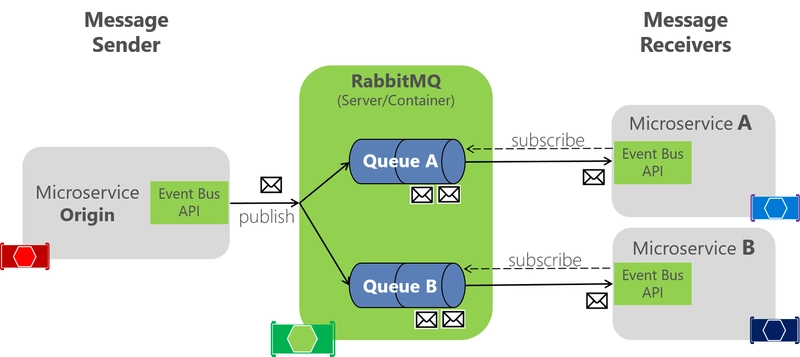Introduction
In a microservices architecture, efficient communication between services is crucial. Traditional synchronous API calls (REST/gRPC) may cause tight coupling and performance bottlenecks. This is where message brokers come in, enabling asynchronous, decoupled, and scalable communication between services.
Among the most popular message brokers is RabbitMQ. In this blog, we will explore its features, use cases, and why it is a great choice for microservices.
What is a Message Broker?
A message broker is a middleware system that facilitates the exchange of messages between different services. It ensures reliable delivery, queues messages when services are unavailable, and allows event-driven communication.
Key Benefits of Message Brokers:
- Decoupling Services – Microservices don’t need to be aware of each other.
- Scalability – Handles large message loads efficiently.
- Asynchronous Processing – Improves performance and responsiveness.
- Fault Tolerance – Prevents message loss with persistent storage.
What is AMQP?
AMQP (Advanced Message Queuing Protocol) is an open standard for message-oriented middleware. It defines how messages are sent, stored, and delivered between distributed systems. RabbitMQ is one of the most popular implementations of AMQP, ensuring reliable and flexible message routing.
Key Features of AMQP:
- Provides message reliability with acknowledgments.
- Supports flexible routing mechanisms.
- Enables asynchronous messaging with queues.
- Ensures interoperability between different programming languages.
RabbitMQ: Traditional Message Queueing
RabbitMQ is a widely-used, open-source message broker that follows the message queueing model. It is based on the AMQP (Advanced Message Queuing Protocol) and is designed for reliable message delivery.
RabbitMQ Architecture:
- Producers send messages to Exchanges.
- Exchanges route messages to one or more Queues based on routing rules.
- Consumers process messages from the queues.
Key Features of RabbitMQ:
✅ Supports multiple messaging patterns (direct, fanout, topic, header-based routing).
✅ Ensures message persistence for reliability.
✅ Provides acknowledgments & retries to avoid message loss.
✅ Offers delayed and scheduled messaging.
✅ Lightweight and easy to deploy.
When to Use RabbitMQ?
✔ Traditional request-response or task queue models.
✔ Guaranteed delivery and message persistence are required.
✔ Low-latency messaging (e.g., order processing, notification systems).
✔ Use cases that require complex routing logic.
Example: RabbitMQ in a Social Media App
Let’s say we have a social media application where users can create posts. One microservice handles post creation, while another microservice processes notifications when a new post is created. RabbitMQ can help ensure reliable communication between these services.
The below gif is a better explanation:

Producer (Post Service - Sends Message to RabbitMQ with Persistence)
const amqp = require('amqplib');
async function sendMessage(post) {
try {
const connection = await amqp.connect('amqp://localhost');
const channel = await connection.createChannel();
const queue = 'new_posts';
// Ensure the queue is durable (messages survive RabbitMQ restarts)
await channel.assertQueue(queue, { durable: true });
// Publish message with persistence
channel.sendToQueue(queue, Buffer.from(JSON.stringify(post)), { persistent: true });
console.log("[x] Sent", post);
setTimeout(() => {
connection.close();
}, 500);
} catch (error) {
console.error("Error sending message:", error);
}
}
sendMessage({ user: 'JohnDoe', content: 'Hello, RabbitMQ!' });
Consumer (Notification Service - Receives Messages with Retry Mechanism)
const amqp = require('amqplib');
async function receiveMessages() {
try {
const connection = await amqp.connect('amqp://localhost');
const channel = await connection.createChannel();
const queue = 'new_posts';
const retryQueue = 'new_posts_retry';
await channel.assertQueue(queue, { durable: true });
await channel.assertQueue(retryQueue, { durable: true });
console.log("[*] Waiting for messages in", queue);
channel.consume(queue, async (msg) => {
if (msg !== null) {
try {
const post = JSON.parse(msg.content.toString());
console.log("[x] New post notification for:", post.user);
// Simulate message processing
if (Math.random() < 0.2) throw new Error("Random failure");
channel.ack(msg); // Acknowledge successful processing
} catch (error) {
console.error("[!] Error processing message:", error.message);
// Retry mechanism: Move message to retry queue
channel.sendToQueue(retryQueue, msg.content, { persistent: true });
channel.ack(msg); // Acknowledge message to remove it from the original queue
}
}
});
// Process retry queue messages
channel.consume(retryQueue, async (msg) => {
if (msg !== null) {
console.log("[!] Retrying message:", msg.content.toString());
// Process retry messages
channel.sendToQueue(queue, msg.content, { persistent: true });
channel.ack(msg);
}
});
} catch (error) {
console.error("Error receiving messages:", error);
}
}
receiveMessages();
How It Works?
- The Post Service sends a new post message to the
new_postsqueue. - RabbitMQ ensures the message is delivered to any listening consumers.
- The Notification Service consumes messages from the queue and triggers notifications.
- If message processing fails, the message is moved to a retry queue and retried later.
- Persistent storage ensures that messages are not lost in case of system failures.
Conclusion
RabbitMQ is a powerful tool in microservices architecture, excelling in reliable message delivery and flexible routing. With added message persistence and a retry mechanism, RabbitMQ ensures that messages are not lost and can be retried, making it an ideal choice for distributed systems.


Top comments (0)